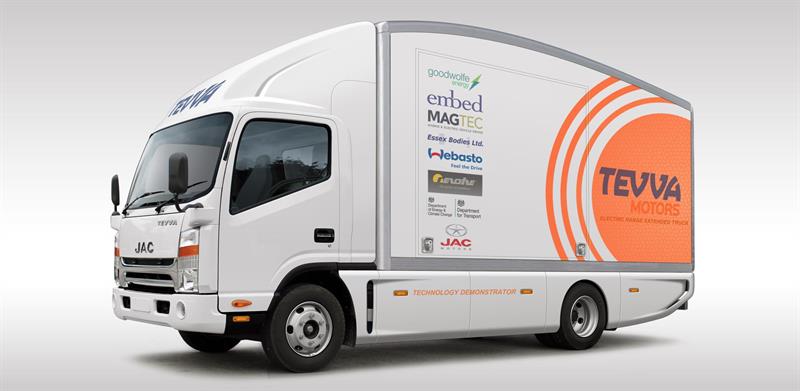Mike Woodcock, AEM’s strategy director, explains the problems previously associated with the technology, saying: “SRMs have traditionally had a couple of challenges – noise, vibration and harshness compared to PM machines. Plus, they have what’s called torque ripple, which means they don’t have a smooth motion. The final challenge of SRMs has been the power electronics. They require quite complex electronics to control the drive, which has tended to make them too expensive and large to integrate into a vehicle.”
However, AEM has developed the HDSRM (High-Density Switched Reluctance Machine), which it claims is the most sustainable motor in the world and overcomes these problems. The motor technology, which is designed for use in hybrid, range-extended and electric commercial vehicles and was developed by James Widmer, AEM’s CEO, also dispenses with the need for the expensive rare earth materials found in PM motors.
Says Woodcock: “What we’ve been able to do with the motor that James developed is to replace a PM machine in a plug-and-play style. We take up exactly the same space and produce slightly better performance than a PM machine and we use the same electronics because of a clever piece of patented technology we have integrated into our machine. We can also deliver a similar level of quietness and smoothness as a PM machine, but the big advantage is that we remove the rare earth materials, which means the bill of materials comes down by 30-40% straight away.”
In putting that technology together, AEM first worked with Cummins and then with Tevva Motors. “They asked that the motor be put into the case for the PM machine and for us to prove it can do what we said,” explains Woodcock. “That was integrated into a truck and it achieved the performance levels, smoothness and torque levels that we claimed. That encouraged James and Dr Andy Stephens to spin the company out of Newcastle University.”
HDSRM will provide an affordable traction solution for its next generation of range extended trucks. HDSRM will act both as traction motor (integrated with Advanced Electrical Machine’s robust gearbox) and as a generator, coupled to Tevva Motors’ range extender.
Says Woodcock: “They asked that the motor be put into the case for the PM machine and prove it can do what you say. That was integrated into a truck and it achieved the performance levels, smoothness and torque levels that we claimed.”
In fact, Tevva had looked around Europe and Asia for a cost-effective motor for its 7.5 tonne truck and couldn’t find one that could perform as well as AEM’s at the cost point it could deliver. “We’ve now got to a point where they’re going into production with their truck and will build 100 this year and maybe 1,200 or 1,300 next year and we are a key part of that powertrain,” says Woodcock.
AEM is also starting to look at broader applications for the motor. HDSRM is modular, so it can be stacked without having to redesign in order to get twice the performance. At the moment that can mean stacking up to five motors, which means it can go anywhere from light commercial vehicles, 7.5 tonne trucks, right up to marine applications with the same design, allowing AEM to benefit from considerable economies of scale.

HDSRM will feature in Tevva Motors' next generation of trucks
The HDSRM has a number of advantages. It can run much hotter and at peak performance for much longer than a permanent magnet machine because there’s no risk of demagnetisation through overheating for the simple reason that it does not have any magnets to demagnetise.
Rather than rare earth metals, the motor works using electromagnetic steels and highly innovative control systems. That means for hybrid systems it makes the design much less complex because it removes the need for a separate cooling loop for the motor, which frees up space and reduces cost. The motor also works as a generator, meaning that it does not pose any challenges in terms of regeneration or energy storage.
Another advantage of HDSRM is that its efficiency band is much broader than a typical PM machine. Says Woodcock: “We typically have 95-97% efficiency from our motor, which means it actually runs from 50km/h to 100km/h, whereas with a PM machine, you’d generally get a much narrower speed range. What that means in the real world is that, where we’re on a truck on a motorway for hours, we have no problem with cooling, which means we don’t lose efficiency that way and we can tune it to ensure it’s at its optimum efficiency for the whole journey.”
While the HDSRM is in production, another switched reluctance technology that is not yet, but which AEM is keen to flag up, is SSRD. This features lightweight, high-strength steels at the core of its rotor, combined with high-performance electromagnetic steels at the edges of the rotor. Says Woodcock: “That allows us to spin the rotor really fast – 2.5 times faster than a typical PM machine could manage because we’re able to get the strength of the motor and the electromagnetic field where we need them.”
Clearly this has the potential to be suited to the wider automotive industry. According to the company, FSRD delivers almost 50% more power than a Nissan Leaf’s motor (a Nissan Leaf produces 80kW and the FSRD produces 120kW). The motor is also 20kg lighter as all the copper usually used in motors is replaced with aluminium.
FSRD is still in development as it has not yet proved possible to overcome some of the issues related to control because it spins too fast. However, in the last 12 months, according to Woodcock, R&D teams are developing technologies around wide band gap semiconductors that can switch and control much more quickly.











